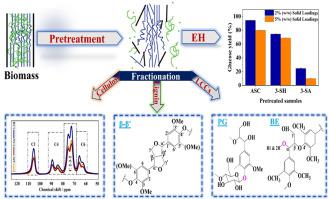当前位置:
X-MOL 学术
›
Carbohydr. Polym.
›
论文详情
Our official English website, www.x-mol.net, welcomes your feedback! (Note: you will need to create a separate account there.)
Unraveling interplay between lignocellulosic structures caused by chemical pretreatments in enhancing enzymatic hydrolysis
Carbohydrate Polymers ( IF 11.2 ) Pub Date : 2024-03-12 , DOI: 10.1016/j.carbpol.2024.122037 Usama Shakeel , Yu Zhang , Evangelos Topakas , Wen Wang , Cuiyi Liang , Wei Qi
Carbohydrate Polymers ( IF 11.2 ) Pub Date : 2024-03-12 , DOI: 10.1016/j.carbpol.2024.122037 Usama Shakeel , Yu Zhang , Evangelos Topakas , Wen Wang , Cuiyi Liang , Wei Qi

|
To investigate the interplay between substrate structure and enzymatic hydrolysis (EH) efficiency, poplar was pretreated with acidic sodium-chlorite (ASC), 3 % sodium-hydroxide (3-SH), and 3 % sulfuric acid (3-SA), resulting in different glucose yields of 94.10 %, 74.35 %, and 24.51 %, respectively, of pretreated residues. Residues were fractionated into cellulose, lignin and unhydrolyzed residue after EH (for lignin-carbohydrate complex (LCC) analysis) and analyzed using HPLC, FTIR, XPS, CP MAS C NMR and 2D-NMR (Lignin and LCC analysis). After delignification, holocellulose exhibited a dramatic increase in glucose yield (74.35 % to 90.82 % for 3-SH and 24.51 % to 80.0 % for 3-SA). Structural analysis of holocellulose suggested the synergistic interplay among cellulose allomorphs to limit glucose yield. Residual lignin analysis from un/pretreated residues indicated that higher β-β' contents and S/G ratios were favorable to the inhibitory effect but unfavourable to the holocellulose digestibility and followed the trend in the following order: 3-SA (L3) > 3-SH (L2) > native-lignin (L1). Analysis of enzymatically unhydrolyzed pretreated residues revealed the presence of benzyl ether (BE) LCC and phenyl glycoside (PG) bond linking to xylose (X) and mannose (M), which yielded a xylan-lignin-glucomannan network. The stability, steric hindrance and hydrophobicity of this network may play a central role in defining poplar recalcitrance.
中文翻译:

揭示化学预处理在增强酶水解过程中引起的木质纤维素结构之间的相互作用
为了研究底物结构和酶水解 (EH) 效率之间的相互作用,用酸性亚氯酸钠 (ASC)、3% 氢氧化钠 (3-SH) 和 3% 硫酸 (3-SA) 预处理杨树,得到预处理后的残渣的不同葡萄糖产率分别为 94.10%、74.35% 和 24.51%。 EH 后将残留物分级为纤维素、木质素和未水解残留物(用于木质素-碳水化合物复合物 (LCC) 分析),并使用 HPLC、FTIR、XPS、CP MAS C NMR 和 2D-NMR 进行分析(木质素和 LCC 分析)。脱木质素后,全纤维素的葡萄糖产量显着增加(3-SH 为 74.35% 至 90.82%,3-SA 为 24.51% 至 80.0%)。全纤维素的结构分析表明纤维素同质异形体之间的协同相互作用限制了葡萄糖产量。未处理/预处理残留物的残留木质素分析表明,较高的β-β'含量和S/G比有利于抑制效果,但不利于全纤维素消化率,并且遵循以下顺序的趋势:3-SA (L3) > 3 -SH (L2) > 天然木质素 (L1)。对酶促未水解的预处理残基的分析表明存在连接木糖 (X) 和甘露糖 (M) 的苄基醚 (BE) LCC 和苯基糖苷 (PG) 键,从而产生木聚糖-木质素-葡甘聚糖网络。该网络的稳定性、空间位阻和疏水性可能在定义杨树的顽抗性方面发挥核心作用。
更新日期:2024-03-12
中文翻译:

揭示化学预处理在增强酶水解过程中引起的木质纤维素结构之间的相互作用
为了研究底物结构和酶水解 (EH) 效率之间的相互作用,用酸性亚氯酸钠 (ASC)、3% 氢氧化钠 (3-SH) 和 3% 硫酸 (3-SA) 预处理杨树,得到预处理后的残渣的不同葡萄糖产率分别为 94.10%、74.35% 和 24.51%。 EH 后将残留物分级为纤维素、木质素和未水解残留物(用于木质素-碳水化合物复合物 (LCC) 分析),并使用 HPLC、FTIR、XPS、CP MAS C NMR 和 2D-NMR 进行分析(木质素和 LCC 分析)。脱木质素后,全纤维素的葡萄糖产量显着增加(3-SH 为 74.35% 至 90.82%,3-SA 为 24.51% 至 80.0%)。全纤维素的结构分析表明纤维素同质异形体之间的协同相互作用限制了葡萄糖产量。未处理/预处理残留物的残留木质素分析表明,较高的β-β'含量和S/G比有利于抑制效果,但不利于全纤维素消化率,并且遵循以下顺序的趋势:3-SA (L3) > 3 -SH (L2) > 天然木质素 (L1)。对酶促未水解的预处理残基的分析表明存在连接木糖 (X) 和甘露糖 (M) 的苄基醚 (BE) LCC 和苯基糖苷 (PG) 键,从而产生木聚糖-木质素-葡甘聚糖网络。该网络的稳定性、空间位阻和疏水性可能在定义杨树的顽抗性方面发挥核心作用。



























 京公网安备 11010802027423号
京公网安备 11010802027423号